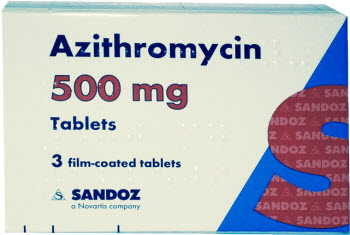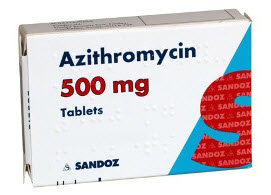
 |
ZithromaxActive Ingredient: Azithromycin |
 |
| $0.44 per pill | Zithromax is used to treat many different types of infections caused by bacteria, such as respiratory infections, skin infections, ear infections, and sexually transmitted diseases. In children, it is used to treat middle ear infection, pneumonia, tonsillitis, and strep throat. |  |
 |
Buy Zithromax 500mg
The antibacterial activity of Zithromax
The spectrum of antimicrobial activity of macrolides is the same. Although the nature of the action is mainly bacteriostatic macrolides, Zithromax 500mg, which creates a high concentration in the tissues exhibits bactericidal activity against a number of pathogens: H. influenzae, M. catarrhalis, N. gonorrhoeae, S. pneumoniae, S. pyogenes, S. agalactiae, Campylobacter spp ., H. pylori, B. pertussis, C. diphtheriae.
Zithromax 500mg is highly active against the likely pathogens of lower respiratory tract infections:
Pneumococcal (IPC 0,03-0,12 g / ml), mycoplasma (MIC 0.001-0.01 g / ml), chlamydia (IPC 0,06-0,25 g / mL), Haemophilus influenzae (MIC 0.25-1 mg / ml), Moraxella (MIC 0.03-0.06 g / ml), staphylococcus (MIC 0.06-0.5 mcg / mL), Legionella ( MIC 0.5 ug / ml).
Zithromax 500mg ranks first among macrolide for activity against H. influenzae, M. catarrhalis, N. gonorrhoeae, B. melitensis, including beta laktoma producents strains. In action on H. influenzae he concedes aminopenicillins and cephalosporins, but is superior to erythromycin in 2-8 times. At a concentration of 1 mg / ml Zithromax inhibits the growth of 100%, erythromycin - 16%, and roxithromycin - 5% strain H. influenzae. The minimum bactericidal concentration (MBC), resulting in the deaths of 99.9% of strains of Haemophilus influenzae, Zithromax is 4 micrograms / ml for erythromycin - 16 mcg / mL for roxithromycin - 64 mcg / mL.
While activity against chlamydia, mycoplasma, ureaplasma, and Legionella in vitro azithromycin is in second place after clarithromycin, in vivo its activity against these intracellular pathogens than the activity of other macrolides because of its extremely high ability to penetrate into cells. MBC of Zithromax against C. pneumoniae varies from 0.06 to 0.125 g / ml. Zithromax 500mg is superior to clarithromycin activity against Coxiella burnetis, causing SARS. In action on mycoplasma Zithromax is superior to doxycycline.
For Zithromax 500mg and other macrolides characterized postantibiotic effect, ie. E. The antimicrobial preservation of the drug after its removal from the medium. This is due to irreversible changes in the pathogen ribosomes, leading to blockage of translocation. Zithromax (less erythromycin and clarithromycin) and has a sub-MIC-postantibiotic effect - effect on microorganisms after exposure subinhibitory concentrations of the antibiotic. Under the influence of the concentration of these drugs even lower MIC microorganisms, including normally resistant to them (Pseudomonas aeruginosa), are more susceptible to immune defense factors. Zithromax 500mg exhibits postantibiotic and sub-MIC-postantibiotic effect against S. pyogenes, S. pneumoniae, H. influenzae, L. pneumophila, the duration of which is superior to clarithromycin.
Zithromax and other macrolides have immunomodulatory and anti-inflammatory activity
Macrolides increase the activity of killer T cells. In particular, the gain is set by action of killing chlamydia Zithromax. Macrolides accumulate in neutrophils, monocytes and macrophages, migrate to enhance the focus of inflammation, increase their phagocytic activity and stimulate the secretion of interleukins IL-1, IL-2, IL-4. Macrolides affect the oxidative reactions in phagocytes (increase superoxide production by neutrophils) and contribute to their degranulation. Azithromycin also accelerates neutrophil apoptosis after elimination of the pathogen. After readjustment the infection macrolides increased production of anti-inflammatory cytokine (interleukin IL-10) by monocytes, decrease the production of pro-inflammatory cytokines (interleukins IL-1, IL-2, IL-6, IL-8, TNF-alpha) by monocytes and lymphocytes, reduced formation of highly oxygen compounds (NO) and the inflammatory mediators - prostaglandins, thromboxanes and leukotrienes, which contributes to the cessation of the inflammatory response. Anti-inflammatory effect is evident even at sub-therapeutic concentrations of macrolide and is comparable to the effect of non-steroidal anti-inflammatory drugs. Since it involves a decrease in the action of macrolides of airway hyperreactivity, is always accompanied by bronchopulmonary infection.
Microbial resistance
All the macrolides are ineffective against microorganisms naturally resistant to erythromycin. In the formation of acquired resistance to macrolides after the termination of the antibiotic over time, sensitivity to it is reduced. Resistant microorganisms macrolide intragroup cross. Cross-resistance to macrolides is also observed in lincosamides. 90-95% of hospital strains of pneumococcus resistant to penicillin-resistant and macrolide. Resistance to macrolides gram-positive cocci in Russia is much lower than in other countries. According to the International multicenter study PROTECT (2002), the prevalence of S. pneumoniae, resistant to erythromycin, in Western Europe is on average 31.5% (1.4% in Sweden and the Netherlands, 12.2% - in the UK, 36.6% - in Spain, 58.1% - in France) . In Hong Kong and Singapore, it reaches 80%. Pneumococcal resistance to penicillin and macrolides in our country is not high, but there is considerable its resistance to tetracycline and co-trimoxazole. Pneumococcal resistance to doxycycline in Russia exceeds 25%. Methicillin-resistant Staphylococcus strains are resistant to all macrolides. In contrast to the Gram-positive microorganisms have been identified development of acquired resistance to macrolides in H. influenzae, M. catarrhalis and intracellular pathogens (mycoplasma, chlamydia, legionella).
Pharmacokinetics of Zithromax 500mg
Zithromax 500mg exhibits higher acid resistance (300 times greater than that of erythromycin) than other macrolides are partially inactivated by the action of gastric acid. All macrolides are readily soluble in lipids and well absorbed from the intestine, but partially exposed biotransformation first pass. Bioavailability of Zithromax 37% of other drugs in this group, it ranges from 10 to 68%. The maximum concentration of Zithromax in plasma after ingestion of 0,3-0,62 g / ml achieved after 2.5-2.9 hours (after receiving the maximum concentration of 500 mg 0,41-0,5 micrograms / ml is created through 2.2 hr). After a single dose, two peaks of maximum concentration recorded. The second peak (often greater than the first) is due to the ability of macrolides to accumulate in the bile and then re-absorption from the intestine. After intravenous drip infusion for 1 hour Zithromax concentration in blood reaches 3.6 g / ml, decreasing after 24 h to 0.2 mg / ml.
The degree of binding to plasma proteins Zithromax 500mg is relatively low and ranges from 7% (at a concentration of 1.2 ug / ml) to 51% (at a concentration of 0.02-0.1 mg / ml). As you know, the less the degree of binding of the drug to a protein, the greater the concentration of the active and the sooner it leaves the bloodstream, penetrating the fabric. For comparison, among macrolide most serum proteins binds roxithromycin (by 92-96%). Thanks to good solubility in lipids Zithromax easily penetrates tissue, accumulating therein, as evidenced by the large volume of distribution - 31.1 L / kg. AUC0-24 azithromycin 4.3 mkg'ch / ml. By the ability to penetrate the blood-tissue barriers (except the blood-brain), azithromycin is superior to beta-lactams and aminoglycosides.
Among the macrolide Zithromax produces the highest concentration of tissue (in the tens or hundreds of times greater than the serum, in most tissues of 1 to 9 mg / g), so its level in plasma is low. Maximum serum concentration observed when receiving roxithromycin, because of its less penetration into the tissue. Zithromax 500mg is found in high concentrations in legkih, sputum, alveolar fluid. After 48-96 h after a single 500 mg azithromycin priema its concentration in the bronchial mucosa in 195-240 times, legochnoy fabric - more than 100 times, and bronchial secretions - 80-82 times in serum.
Unlike most other antibiotics, macrolides penetrate well (in most Zithromax) inside cells and provide long-term persistence of high intracellular concentrations. Erythromycin they have 17 times, at clarithromycin - in 16-24 times at azithromycin - 1200 times the concentration in the blood. Macrolides accumulate in various cells, including fibroblasts, epithelial cells and macrophages. In a particularly large quantities, they accumulate in the lysosome membrane phospholipid layer phagocytic blood cells (neutrophils, monocytes) and tissue (alveolar macrophages). Phagocytes loaded macrolides, transport them to infectious and inflammatory foci when migrating under the influence of chemotactic factors secreted by bacteria, creating in it the concentration of the antibiotic higher than in healthy tissues. It correlates with the severity of the inflammatory edema.
The diffusion process in macrophages roxithromycin and clarithromycin takes 15-20 minutes Zithromax - up to 24 hours, but the maximum concentration in the cells remain for about 48 h Macrolides are released from macrophages, neutrophils and monocytes during phagocytosis by the action of bacterial stimuli.. Some is absorbed by them again, some received inside macrophages macrolides bind irreversibly to proteins of lysosomes. Directed delivery of the antibiotic is of particular importance in the case of infection in limited loci.
Zithromax 500mg have the longest T1 / 2 (after receiving the first 10-14 hours, in the range of 8 to 24 hours after priema - 14-20 h from 24 h to 72 - 35-55 hours after repeated prieme - 48-96 h on average 68-71 hours), the antibiotic that assigns only once a day. The half-life of the tissues is much greater. Therapeutic concentration of azithromycin in tissues stored for 5-7 days after discontinuation (erythromycin - 1-3 days). Macrolides are mainly extrarenal pathway of elimination. They are subject to biotransformation (demethylation, hydroxylation) in the liver, with the participation of cytochrome P-450 (mainly its isoenzyme CYP3A4) and excreted in the bile in high concentrations in the form of active (clarithromycin, midecamycin) or inactive metabolites and not modified form. Zithromax 500mg partially biotransformation in the liver (10 known metabolites) and 50% of the dose is excreted in the bile in the form of not modified. A small part of the dose (at the Azithromycin - 6% of the oral and intravenous doses of 11-14%) is excreted in urine.
Renal insufficiency and cirrhosis of the liver have no effect on the pharmacokinetics of Zithromax. With respect to other macrolides may require correction dosing regimen. Elderly patients pharmacokinetics macrolides does not change significantly and correct dosing regime have not required.
Buy Cheap Zithromax 500mg Online

Zithromax 500 mg
Package |
Per pill |
Price |
Savings |
30 pills Free Viagra, Cialis or Levitra pills |
$2.49 |
$74.58 |
|
60 pills Free Viagra, Cialis or Levitra pills |
$1.74 |
$104.41 |
$44.75 |
90 pills Free Viagra, Cialis or Levitra pills |
$1.49 |
$134.24 |
$89.50 |
120 pills Free Viagra, Cialis or Levitra pills |
$1.37 |
$164.08 |
$134.24 |
180 pills Free Viagra, Cialis or Levitra pills
Free AirMail shipping |
$1.24 |
$223.74 |
$223.74 |
270 pills Free Viagra, Cialis or Levitra pills
Free courier delivery |
$1.16 |
$313.24 |
$357.98 |
360 pills Free Viagra, Cialis or Levitra pills
Free courier delivery |
$1.12 |
$402.73 |
$492.23 |
▼ Click HERE to See All Prices / Buy Zithromax 500mg
Zithromax Reviews
Lana Kim, 31
Excellent preparation - always helps and zero side effects! Thank producers. Bronchitis can be cured by a pack 3 capsules and convenient to use once a day and after taking capsules of the drug is in the inflammation 5-7 days acting on bacteria !!!!
Katrin Miller, 40
Zithromax unique antibiotic after application of the first capsule has passed the runny nose and the sensation of pain in the throat. The second capsule is completely removed all of these symptoms, and after the third lost even cough, and I am completely healthy. True downside is that during pregnancy and lactation, it should not be taken, it is possible, but with extreme caution. Antibiotic strong and is even a slight dizziness. Be careful not to overdose because it may even cause hearing loss stop. In general, carefully read the instructions before using this medication. It is not just useful, but also important for yourself just because I have after taking the first capsule was dizziness.






